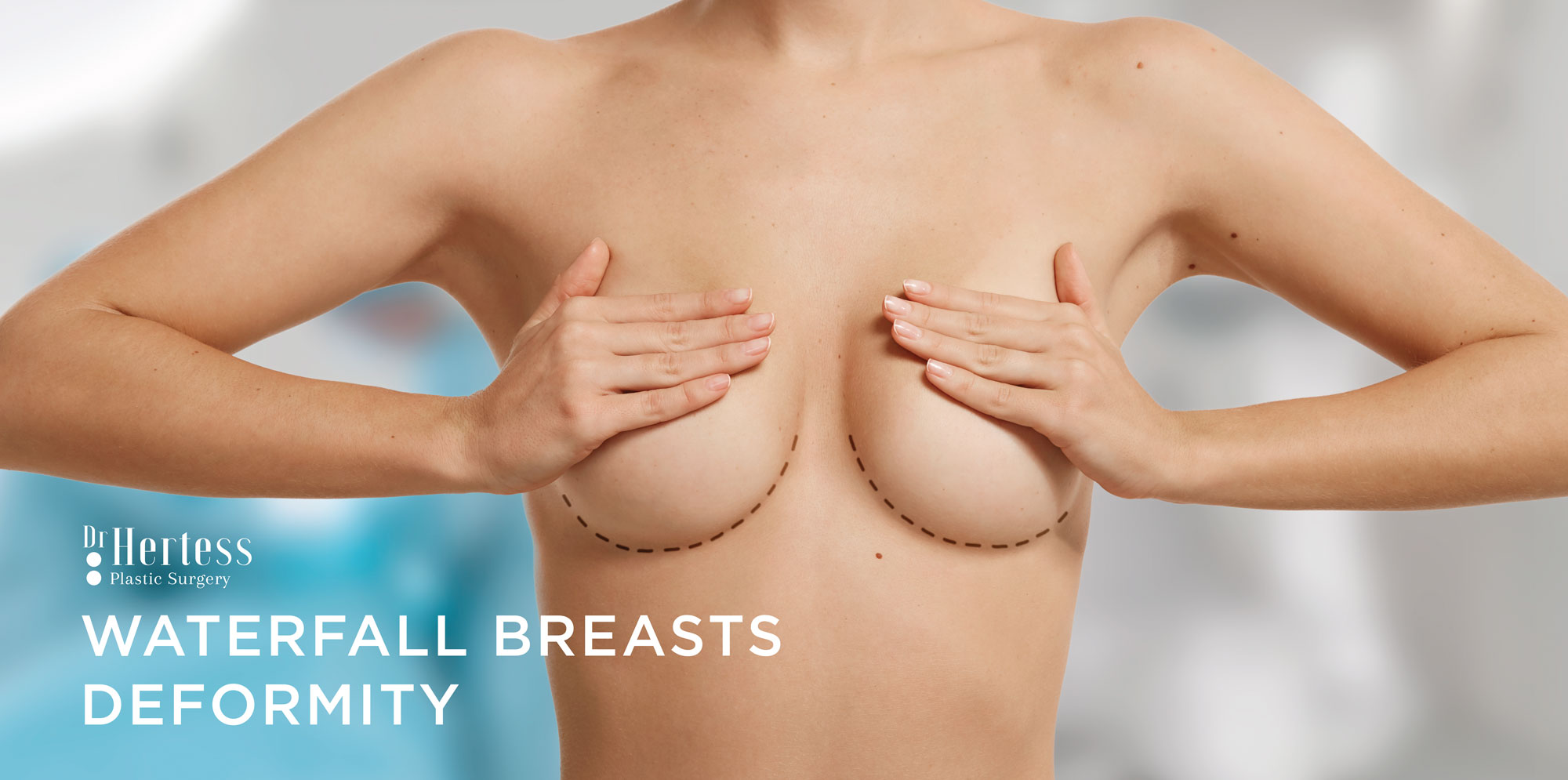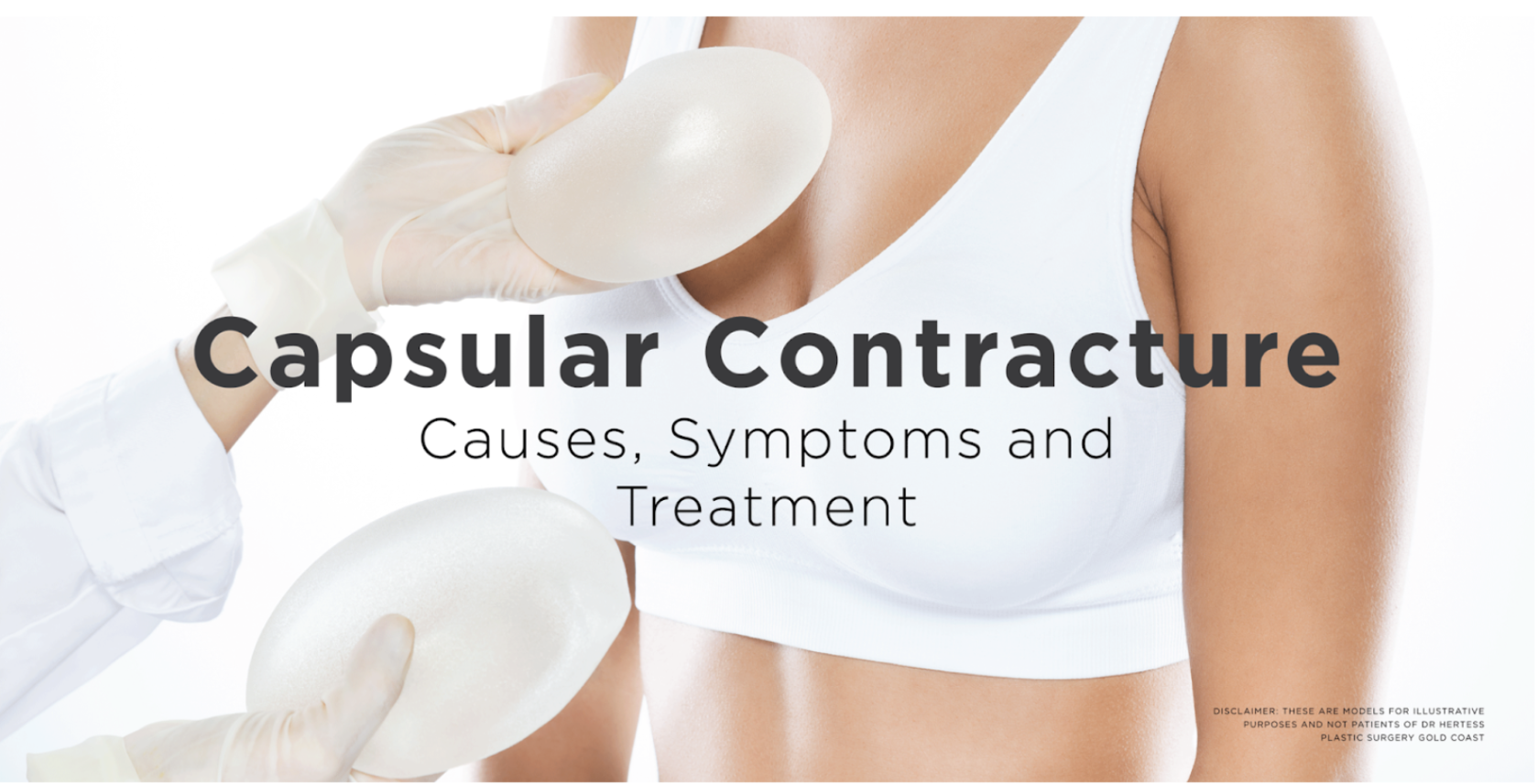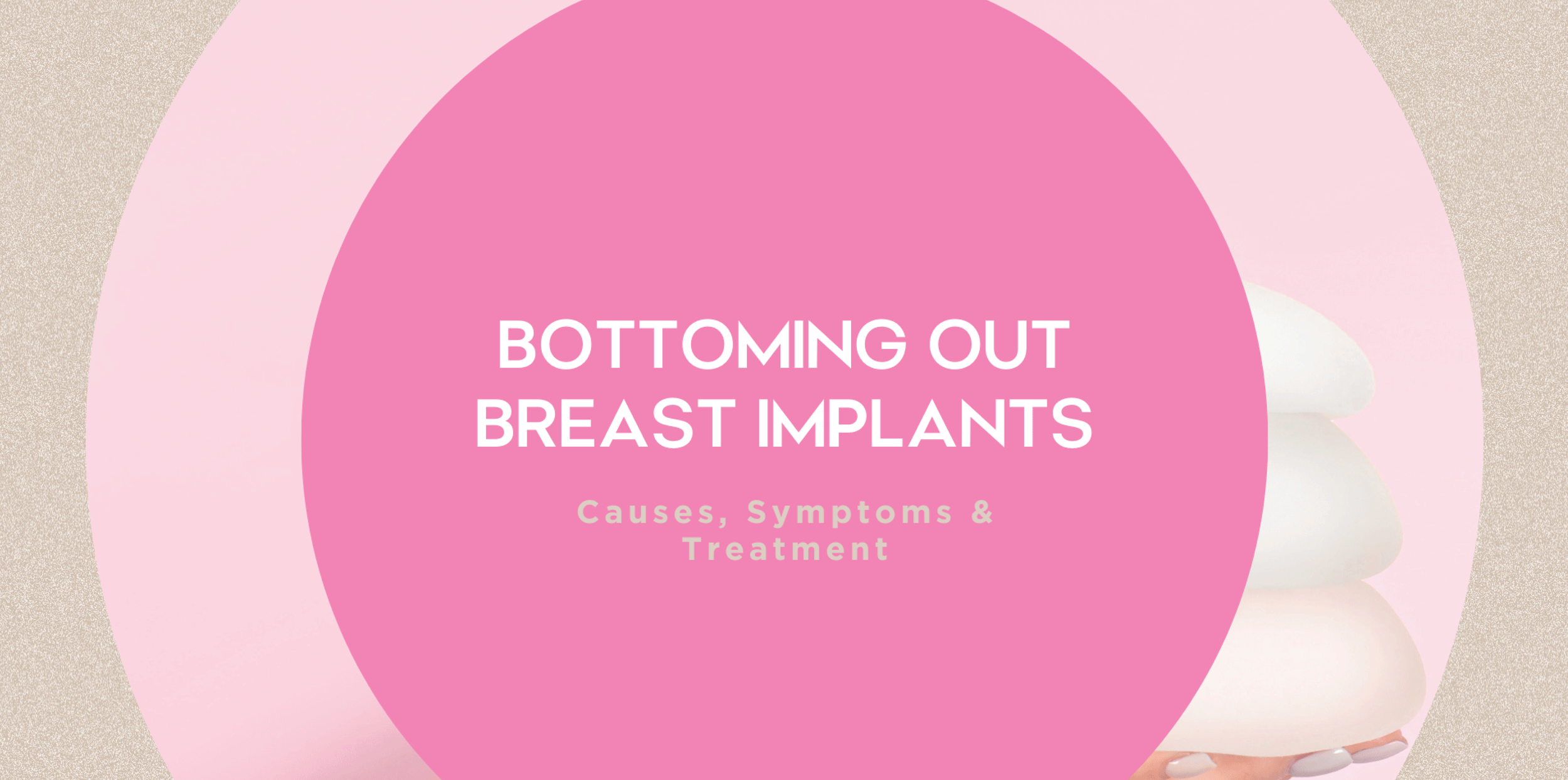Waterfall Breast Deformity - Causes, Symptoms, Diagnosis and Treatment

Breast augmentation is a popular cosmetic surgery procedure on the Gold Coast and worldwide. While women often enjoy lasting results from breast implants, the procedure has its potential complications. One potential complication after implant surgery is the waterfall breast deformity, also known as snoopy nose breast deformity.
Waterfall breast implant deformity is condition that impacts the results of augmentation surgery. In this condition, the breast implant sits high on the chest with a noticeable sag or “waterfall” effect. This deformity is most common in women who have had breast implants for an extended period of time and may be caused by several factors.
Dr Hertess FRACS(Plas) is a Specialist Plastic Surgeon with over 27 years of experience addressing breast implant concerns and complications. In this article, Dr Hertess aims to provide you a thorough overview of the waterfall deformity, including causes, signs, symptoms as well as how to diagnose, treat and prevent snoopy breasts.
.jpg?width=7558&height=5045&name=DSC_9005-3%20(1).jpg)
Dr. Isolde Hertess (MED001372020), Specialist Plastic and Reconstructive Surgeon.
What is the Breast Implant Waterfall Effect?
The snoopy nose breast deformity refers to a condition where your breast tissue and breast implant appear to be disconnected. Essentially, the breast tissue descends or spills over the breast implant.
It is called a waterfall effect because the breast tissue creates a waterfall appearance over the top of the implant. Likewise, it can be referred to as snoopy nose because the breast tissue can create a “nose” or pointed shape below the implant, resembling the cartoon character Snoopy.
What Causes Waterfall Breasts?
There are several potential causes of waterfall breast deformity, including:
- Poor implant placement: If the implants were placed too high on the chest during surgery, it can lead to excess skin and sagging after surgery. Likewise, breast implants that have a low lying nipple are placed underneath the pectoral muscle have a higher likelihood of this breast appearance.
- Oversized breast implants: Implants that are overly large can add gravitational force to the breast tissue. This increases the chances of downward displacement over time.
- Weight fluctuations: Significant weight gain or loss can cause changes in the breast tissue and skin, leading to a waterfall effect.
- Post pregnancy: Women who have had breast implants and then become pregnant may experience changes in the breast tissue that can contribute to waterfall breasts.
- Breastfeeding: Breastfeeding can lead to changes in breast tissue and skin, which may contribute to a waterfall breast deformity.
- Ageing: As we age, our skin and tissues naturally lose elasticity, which can contribute to sagging of the breast tissue over an implant.
- Capsular contracture: This is a complication where the body forms a tight capsule of scar tissue around the implant, causing the implant to sit higher on the chest.
Another common cause of snoopy boob is that a breast lift is not performed at the time of your initial surgery. If you have mild ptosis or sagging, you may be recommended to have a lift at the time of your implant surgery.
"Enough tissue needs to be removed so the breast sits snug against the implant," says Dr Hertess.
"It's normal that your breast size and shape will change over time, so we anticipate this when planning for breast implant surgery."
While some degree of waterfall effect may be normal, excessive sagging over the implant can cause some aesthetic concerns or embarrassment for women.
Signs and Symptoms of Snoopy Breast Implant Deformity

Image 2: Waterfall breast deformity. Real patient of Dr. Isolde Hertess.
The most noticeable symptom of waterfall breasts is the appearance of a “waterfall” or “snoopy nose” effect on the breasts. Some other common signs and symptoms of waterfall breast deformity include:
- A noticeable gap between the breast tissue and implant
- Breast sagging or breast tissue spilling over the implant
- The nipple position is lower than the centre of the breast
If you are experiencing any of these symptoms, it is important to consult with a Specialist Plastic Surgeon for an accurate diagnosis and treatment plan.
Diagnosis of Waterfall Breast Deformity
The process of diagnosing a snoopy breast implant is a crucial step in fixing it. Even though the issue might seem pretty clear, there may be other hidden problems too. That's why, it is important to check the breast tissue and the implant properly.
Based on what is found during this check-up stage, you may need breast implant revision surgery. The technique used in revision surgery will vary depending on what is found when diagnosing the problem.
Consultation
During a consultation, your surgeon will assess the appearance of your breasts and ask about any symptoms you may be experiencing. A physical exam is performed to check for signs of capsular contracture or excessive scar tissue around the implant.
Imaging
In some cases, imaging tests such as an ultrasound or MRI may be recommended to get a better look at waterfall deformity breast implants. These tests can help assess the breast tissue, the implant's position and any potential issues such as the integrity of the implant. Imaging helps Dr Hertess to plan for your correction surgery.
Treatment Options for Waterfall Deformity after Breast Implants Surgery

Image 3: Correction of waterfall breast deformity via implant exchange and lift. Real patient of Dr. Isolde Hertess.
Surgical Procedures to Correct Snoopy Nose Breast Deformity
There are multiple surgical treatment options for waterfall effect implants, these include:
- Breast Lift or Reduction: In some cases the breast tissue needs to be lifted or reduced and the breast implant can stay the same. This is typically the case for newer breast implants.
- Implant Exchange with a Lift: If the implant is aged or in an incorrect position, the treatment involves replacing the implant and lifting the breast tissue.
- Internal Bra Technique: An internal bra can be used to support the breast tissue and hold it in place over the implant. This can be an effective treatment for severe cases of waterfall breasts.
Recovery After Waterfall Breasts Surgery
The recovery process for fixing snoopy breast deformity varies depending on the specific surgery performed. However, most patients can expect to take about 2 weeks off of work and regular activities.
After breast surgery, healing takes place over 6 weeks. During this time you will be required to wear a compression garment and avoid strenuous activity.
You may experience some discomfort, swelling, and bruising during this time. It is important to follow your surgeon's post-operative instructions to ensure proper healing and the best possible results.
Potential Risks
As with any surgery, there are potential risks and complications. Some of these include:
- Infection
- Bleeding or haematoma
- Numbness or changes in sensation to the breasts and nipples
- Breast asymmetry or unevenness
- Scarring
It is important to discuss these possible risks with your surgeon before choosing to undergo waterfall breasts surgery. Always seek a second, unbiased opinion.
How to Prevent Snoopy Breast
While there is no guaranteed way to stop natural changes happening in the breast, there are a few steps you can take to minimise the risk:
Choose the Correct Size Breast Implant
Choosing the right size breast implant is crucial in preventing snoopy breast deformity. Your surgeon will help you select a size that is proportionate to your body and can support the weight of the implant without sagging excessively.
Anticipate that Breast Tissue is Heavy
Get a lift at the time of your initial surgery. If you have mild ptosis or sagging, you may be recommended to have a lift at the time of your implant surgery. This helps prevent excessive sagging over time and can improve the longevity of your results.
Place your Implants Above The Muscle
Subglandular placement can also help prevent snoopy breast deformity. Placing the implant above the muscle means that the weight of the implant is supported by the breast tissue.
Follow Post-Operative Instructions
Following your surgeon's post-operative instructions, such as wearing a compression garment and avoiding strenuous activity, can help optimise your healing and prevent complications that could lead to snoopy breast deformity.
By taking these steps, you can help minimise the risk of developing waterfall breasts after breast augmentation surgery.
Waterfall Deformity Breast Implants FAQs
When is a waterfall breast deformity likely to occur?
This can happen as early as 6-12 months after your surgery or it may occur after 10 or more years. It depends on what is causing the deformity.
How can you avoid waterfall/snoopy nose deformity after breast implant surgery?
To avoid this risk happening after surgery, there are numerous things you can do - from picking the right implant to choosing a skilled plastic surgeon, and staying healthy.
Regular check-ups with your plastic surgeon and following your after surgery instructions are key to spotting and dealing with Snoopy Nose Deformity before it worsens.
Is it possible to fix waterfall breasts without surgery?
For those with milder forms of this condition, non-surgical methods such as wearing supportive bras or doing certain exercises may help. However, surgery is often needed for more serious cases. Replacing implants and/or lifting the breast is the best way to make your breasts look natural again.
Book Your Consultation on the Gold Coast
Having breasts that you feel happy with is important. If you're worried about waterfall deformity or are thinking about getting breast implants, Dr. Hertess can help.
Schedule a consultation with Dr. Hertess today to talk about your options and how to prevent or fix breast implant complications including the waterfall breast deformity.
CONTACT US



